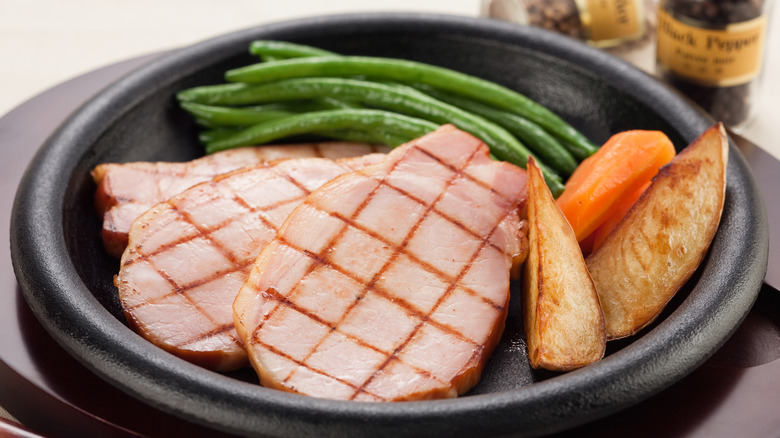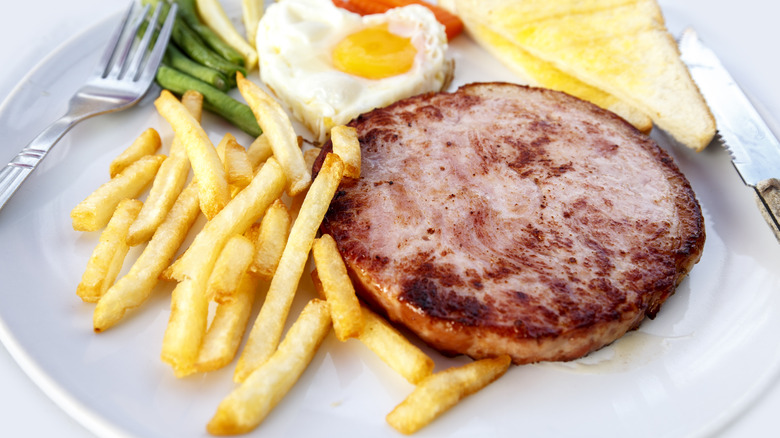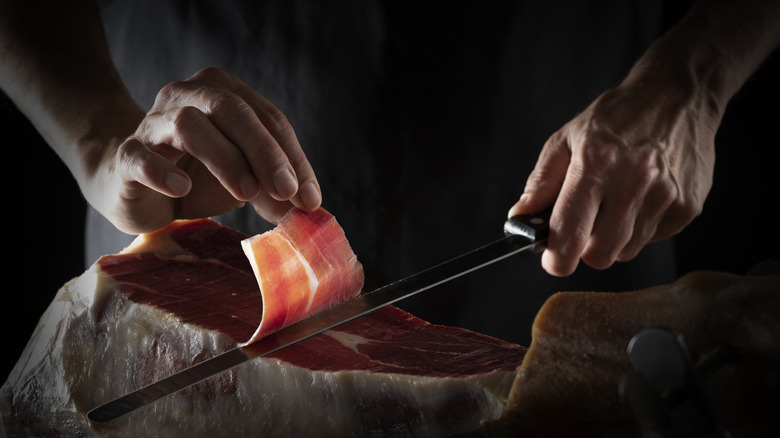Why You Can Only Buy Ham Steaks Pre-Cooked
Ham steaks are a quick and easy choice for any meal. The ham steak comes from the leg or shank of the pig and has a dense and fleshy texture that holds up well with many cooking and preservation methods. From ham and eggs to the main protein paired with mashed potatoes and vegetables, ham steaks make a perfect and easy addition to any meal. And this is in good part because they're pre-cooked. Yes, most ham steaks sold in grocery stores are already cooked and only require heating before serving.
But why is it that ham steaks, unlike other pork cuts, are sold almost exclusively in their cooked form? Well, the answer comes down to food safety. Ohio State University's College of Food, Agricultural, and Environmental Sciences explains that all hams sold in the United States are processed according to specific guidelines to kill trichinae, a parasite that can live inside pork products. These can infect humans if meat from pigs is not properly preserved or cooked. But there is no need to worry, all ham products sold in commercial grocery stores have already been cooked to eliminate the parasite. According to the USDA, cooking ham or pork to 160 degrees Fahrenheit will kill trichinae and other potentially hazardous elements such as staphylococcus aureus, a dangerous bacteria.
Cured, cooked, and smoked
As it turns out, there is more than one way to cook a pig. Or rather, there is more than one way to prepare a pig for eating. And when it comes to ham, there are several methods used to make the food safe for eating. Hams are cured through a variety of processes, dry curing, which involves rubbing salts and nitrates on its surface, to wet curing, which involves putting the cut of ham in a saltwater bath along with spices, sugar, and other flavorful elements to make your ham both tasty and safe for eating. Curing pork works through the process of evaporating water from the meat to make it safe from bacteria and parasites. In addition to curing, many hams are also smoked. Smoking ham helps to add more flavor to the cut of meat, giving a distinct and smoky taste.
But just because you don't have to cook your ham steak, doesn't mean that you can't have fun preparing your meat. Pan-frying your ham steak in butter can give it a nice, browned color and add to its already rich flavor. Additionally, giving your steak a bourbon brown sugar glaze can make it extra indulgent, bringing out some sweetness in your salty cut of ham.
A brief history of ham
Salting, smoking, and curing are necessary for preparing ham for consumption. From ham steaks to spiral-baked hams, most ham products you can buy at the grocery store are ready to eat and only require heating before serving. These preservation processes are essential to what makes ham, well, ham. In fact, there is a long, rich (and salty) history behind the practice of curing pork.
Humans have been curing ham since 4,900 B.C.E., a practice that began in China and soon spread throughout the ancient world. Curing and salting ham proved to be an essential food preservation method, making the meat portable and keeping large swaths of meat edible for long periods. But beyond its benefits in longevity, curing, and salting ham also proved to be essential for avoiding spoilage and food poisoning. Prosciutto, for example, was developed to stretch meat supplies through the winter, but it also has the benefit of being safe to eat when stored at room temperature. In North America, ham became popular during and after colonization as many pork products were lost due to spoilage. As such, curing and salting became popular to avoid these losses and allow for a longer shelf life for ham. Curing ham also made it possible to transport the meat product long distances, and the practice has continued to be standard practice in the American meat industry.
Still, not all ham is safe to consume uncooked, and it's the reason you should check the label on a package of ham steaks. But this historical pursuit of longer-lasting, safer, and more convenient foods which turned raw pork into ham thousands of years ago, is the same impulse that turned raw ham legs into the pre-cooked packaged ham steaks we know today.


